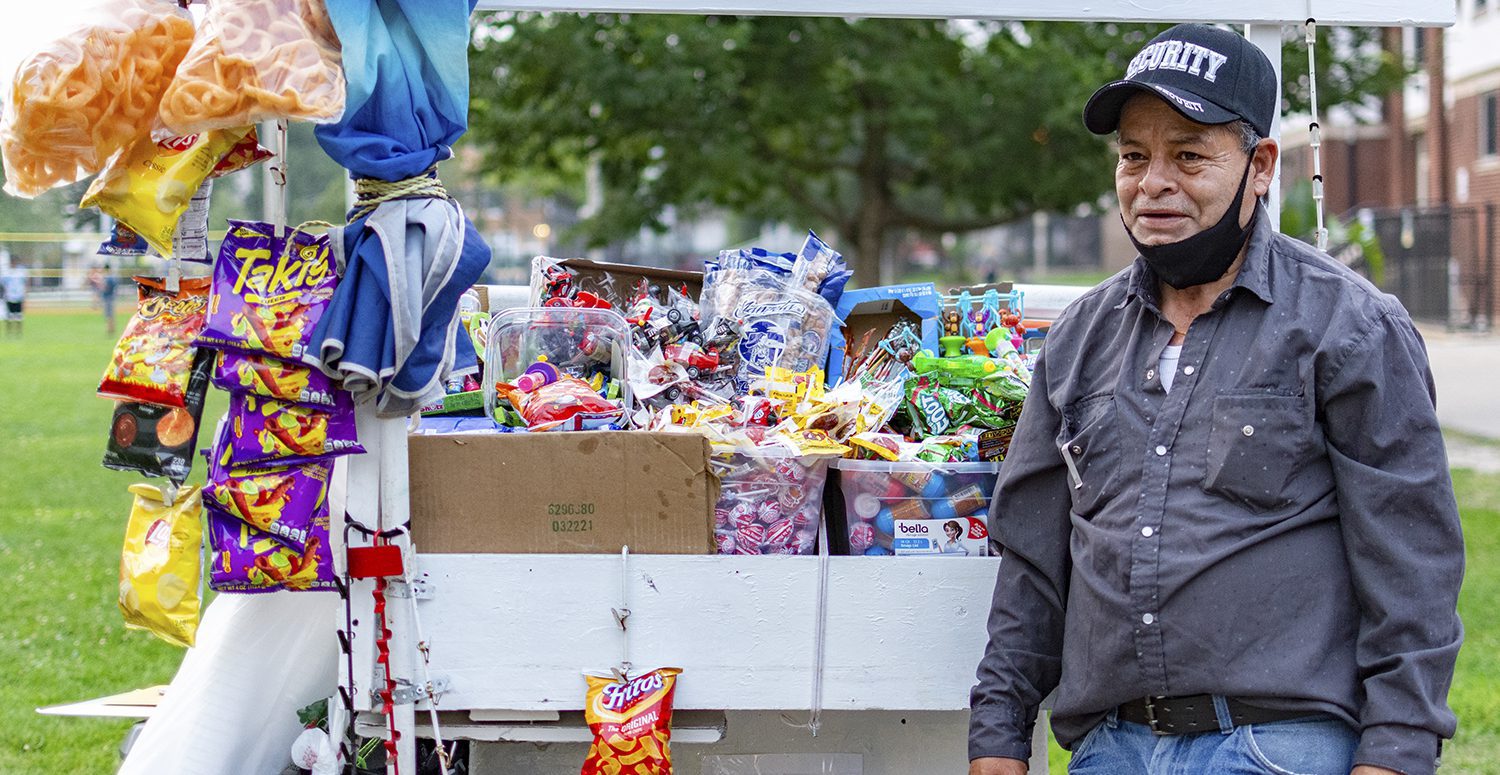 Fotografía de Natalie Garcia para Borderless Magazine
Fotografía de Natalie Garcia para Borderless MagazineLa fotógrafa Natalie García visita a los vendedores ambulantes regentados por inmigrantes en el Northwest Side de Chicago que han persistido a pesar de la pandemia.
En un año normal, los vendedores ambulantes ya tienen que hacer frente a duros requisitos, desde la obtención de permisos hasta el cumplimiento de las normas de zonificación. Durante la pandemia, se enfrentaron a una nueva serie de retos.
Noticias que ponen el poder en el punto de mira y a las comunidades en el centro.
Suscríbase a nuestro boletín gratuito y reciba actualizaciones dos veces por semana.
Borderless Magazine habló con 28 vendedores ambulantes de Chicago sobre sus experiencias durante la pandemia de COVID-19. Los vendedores inmigrantes, que constituyen la mayoría de esta comunidad, se enfrentaron a menudo a barreras lingüísticas y tecnológicas para recibir la asistencia adecuada. Para llegar a fin de mes, muchos siguieron trabajando durante la pandemia, aunque eso significara arriesgar su salud para vender a menos gente o encontrar un segundo o tercer empleo.
Francisco Acosta, que regenta un carrito en la zona noroeste de Chicago en el que vende helados, raspados, patatas fritas, chicharones y dulces mexicanos, se vio obligado a dejar de trabajar el pasado mes de marzo a causa de la orden de no volver a casa. El invierno, durante el cual Acosta suele depender en gran medida de la afluencia extraescolar, no le reportó ingresos: Se vio obligado a quedarse en casa. El verano pasado sólo pudo trabajar dos meses, que suele ser su temporada alta. La pérdida de afluencia a los parques, iglesias y escuelas locales, que estaban cerrados, le dejó con pocos lugares que visitar. La mayoría de los días sólo pasaba tres horas en los tranquilos parques.
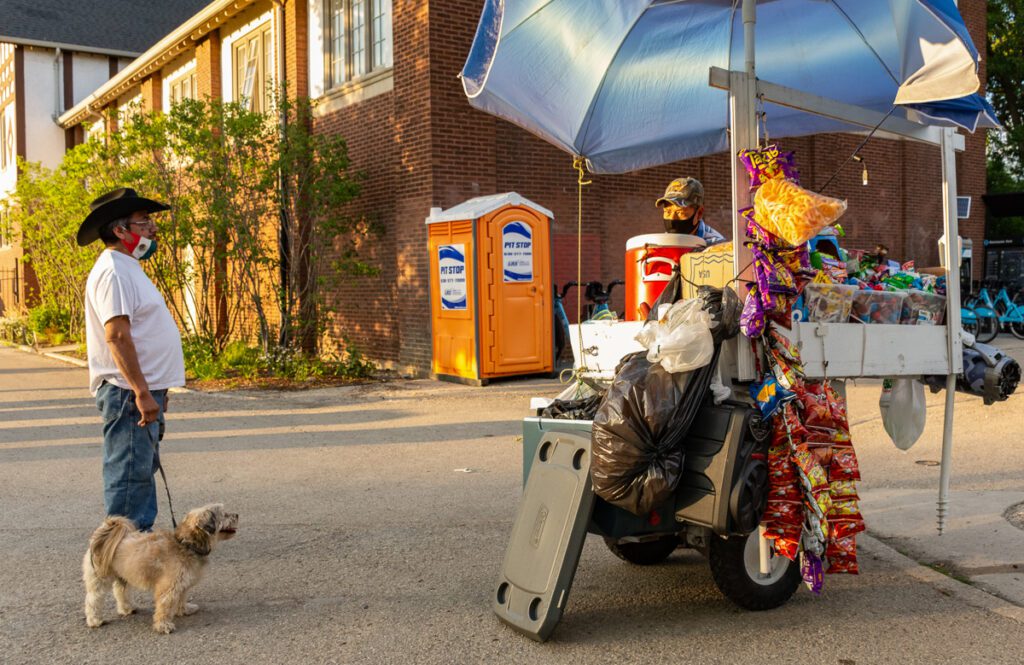
Francisco Acosta habla con un amigo de la comunidad mientras vende en el Northwest Side de Chicago, Ill. Acosta suele poner música para animar el ambiente mientras está en el parque. Foto de Natalie Garcia para Borderless Magazine
Aunque lleva más de 12 años como vendedor ambulante en el barrio, Acosta no pudo optar a ningún cheque de estímulo federal, subvención federal o programa de ayuda a las empresas. Las opciones que ofrece el gobierno a los vendedores ambulantes inmigrantes como Acosta son escasas o nulas. En su lugar, como muchos otros vendedores, ha tenido que recurrir a campañas de recaudación de fondos de base, como la organizada el año pasado por Aumentar la Paz, que elevado cerca de $50.000 para los vendedores ambulantes. Acosta recibió un cheque único de $500 de esa campaña, su única forma de alivio en 2020. Tuvo problemas para pagar el alquiler en 2020 y sigue intentando ponerse al día.
Raúl y María Salgado llevan más de 15 años vendiendo en el barrio Avondale de Chicago una gran variedad de aperitivos y raspados naturales como tamarindo, lechera (leche condensada azucarada acompañada de fruta madura) y diablitos (hielo raspado picante con siropes caseros) durante las estaciones cálidas. En invierno tienen otros trabajos: María es costurera y Raúl trabaja en una fábrica. Durante la pandemia, también complementaron sus ingresos fabricando mascarillas y limpiando en restaurantes locales. Han seguido trabajando y encontrando empleo donde han podido.

María Salgado limpia el carrito de comida que regenta con su marido después de una venta en el barrio de Avondale de Chicago, Ill. Foto de Natalie Garcia para Borderless Magazine
"La vida no cambió mucho, sólo comimos menos", dijo Raúl Salgado.
La venta ambulante es un trabajo a tiempo completo, pero para muchos es algo más que unos ingresos. Al preguntarle por la venta ambulante y sus ventajas, Raúl dice que le gusta hablar con gente de culturas diferentes. También le gusta estar libre de las presiones de un trabajo con jefes y gerentes. Aunque dice que gana menos de lo que ganaría en otro sitio, en realidad disfruta con lo que hace para ganarse la vida y valora la oportunidad de pasar más tiempo en casa con su familia.
Del mismo modo, Mayra Soto, vendedora ambulante en el barrio de Belmont Cragin, valora el aspecto social de lo que hace. Cuando está fuera con su carrito, vendiendo elotes, chicharones y dulces, suele charlar y ponerse al día con los vecinos. Más que su trabajo a tiempo parcial para llegar a fin de mes, la venta ambulante es para ella una forma de conectar con su comunidad.
Este verano, los vendedores ambulantes vuelven a salir a los barrios, intentando recuperar el tiempo y el dinero perdidos, a pesar de la creciente preocupación por la variante Delta de COVID-19.
"En realidad, el vending no tiene nada de especial", afirma Raúl Salgado. "Es que hay que seguir luchando en la vida para salir adelante, ganarse la vida y prosperar".
Noticias que ponen el poder en el punto de mira y a las comunidades en el centro.
Suscríbase a nuestro boletín gratuito y reciba actualizaciones dos veces por semana.
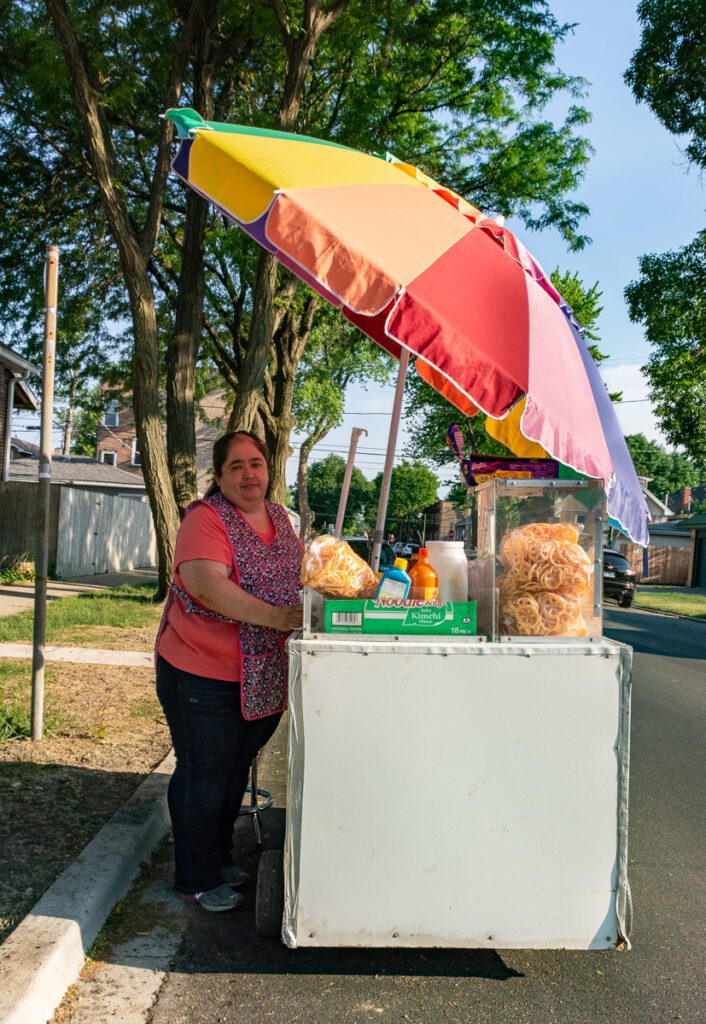
Mayra Soto, que lleva más de 10 años vendiendo elotes y chicharones, es muy conocida en el barrio de Belmont Gardens, en Chicago (Illinois). Foto de Natalie Garcia para Borderless Magazine
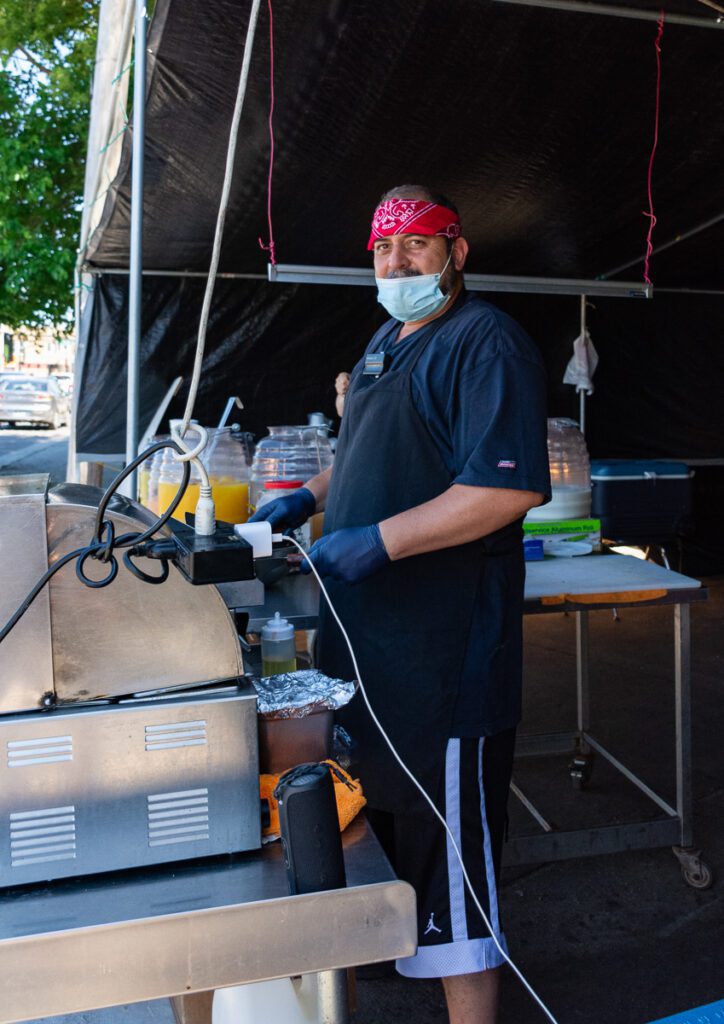
Mario Chávez y su familia abrieron su negocio, Tacos El Primazo, este año después de que se levantaran las restricciones de permanencia el 11 de junio en Chicago, Ill. Tacos El Primazo vende aguas y fruta durante la semana y tacos los fines de semana cuando hay más demanda en el barrio de West Humboldt Park en Chicago, Ill. Foto de Natalie Garcia para Borderless Magazine
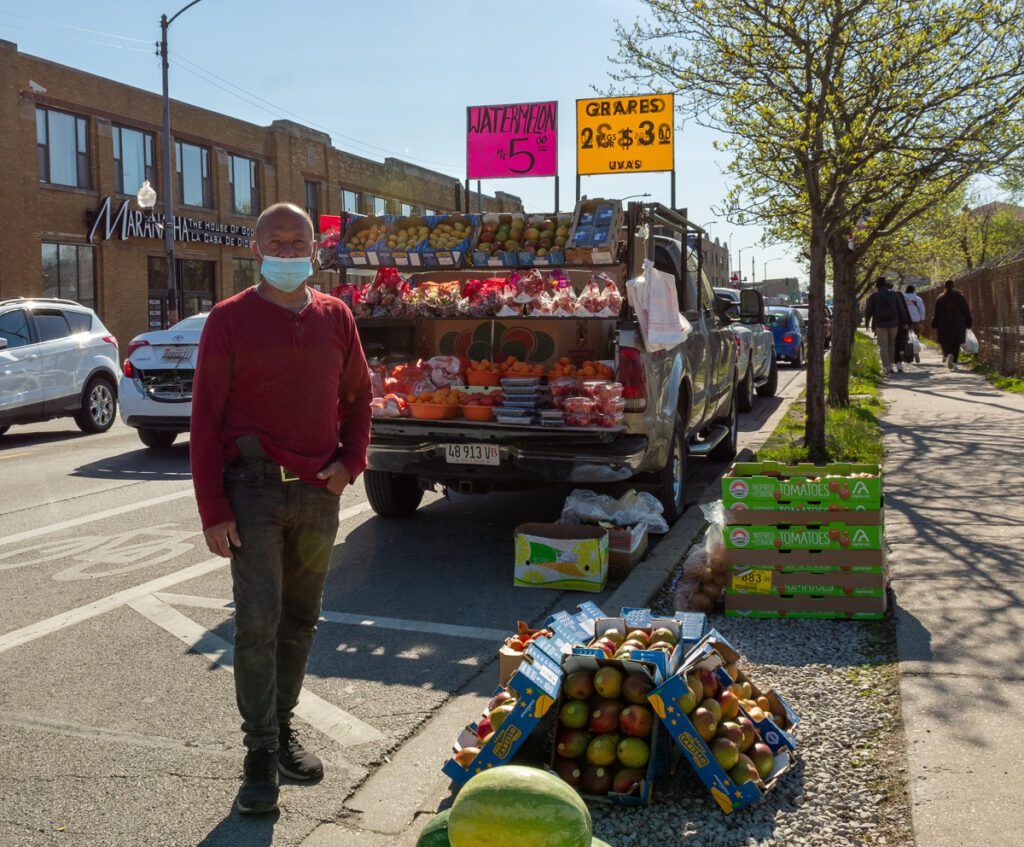
Jorge (cuyo apellido Borderless mantiene en reserva por motivos de privacidad) vende fruta a granel en el barrio de Hermosa, en Chicago (Illinois). Foto de Natalie Garcia para Borderless Magazine
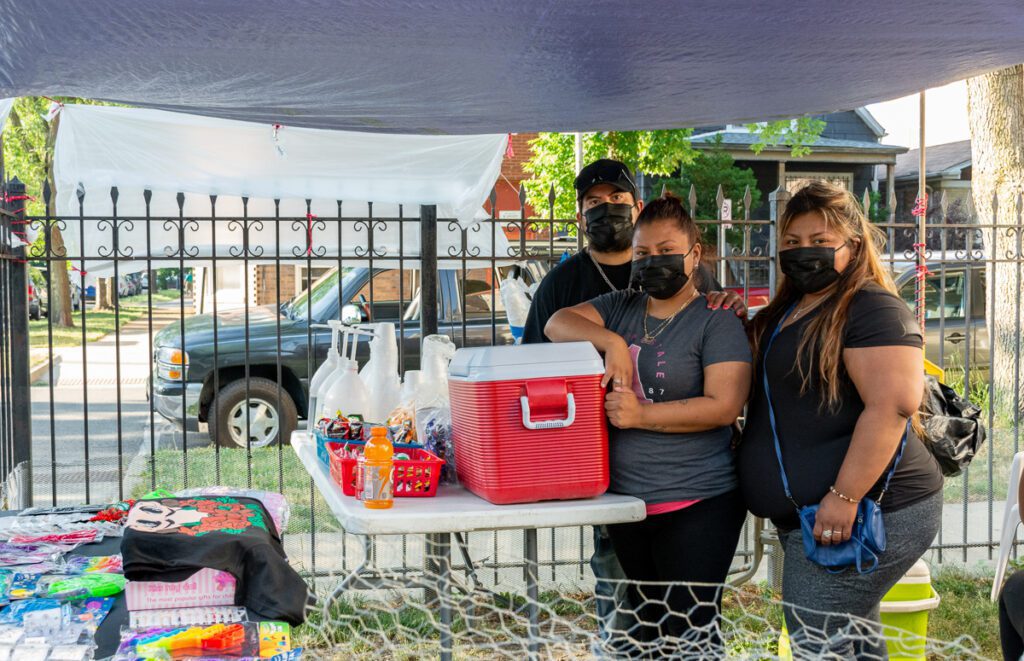
De izquierda a derecha: Ángel Girón, su esposa Joanna Flores y Daisy Flores, prima de Joanna, venden cucuruchos de nieve, aperitivos y juguetes frente a su casa de Hermosa, en Chicago (Illinois). Ser vendedor ambulante es una especie de tradición familiar: Los padres de Flores solían vender. Ya jubilados, a veces se sientan fuera y observan el negocio. Foto de Natalie Garcia para Borderless Magazine
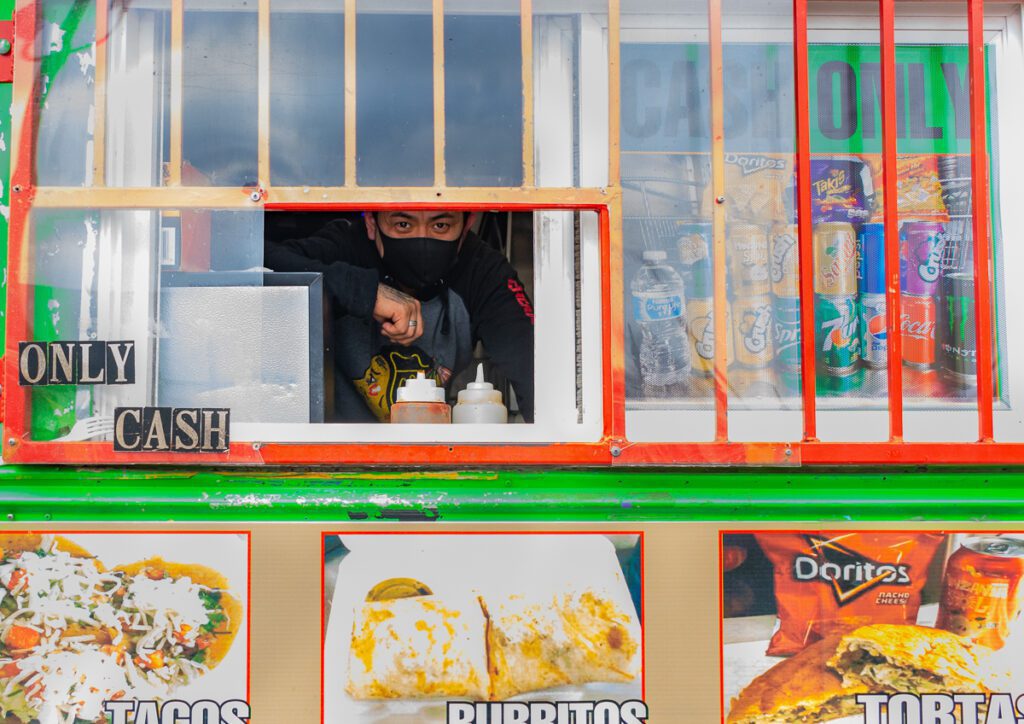
Carlos Lagunas, propietario de Tacos Lagunas Food Truck, vende tacos, tortas, aperitivos y bebidas en el barrio de Austin, en Chicago (Illinois). A menudo atiende a la afluencia de almuerzos del Corredor Industrial del Noroeste y sus alrededores. Foto de Natalie Garcia para Borderless Magazine
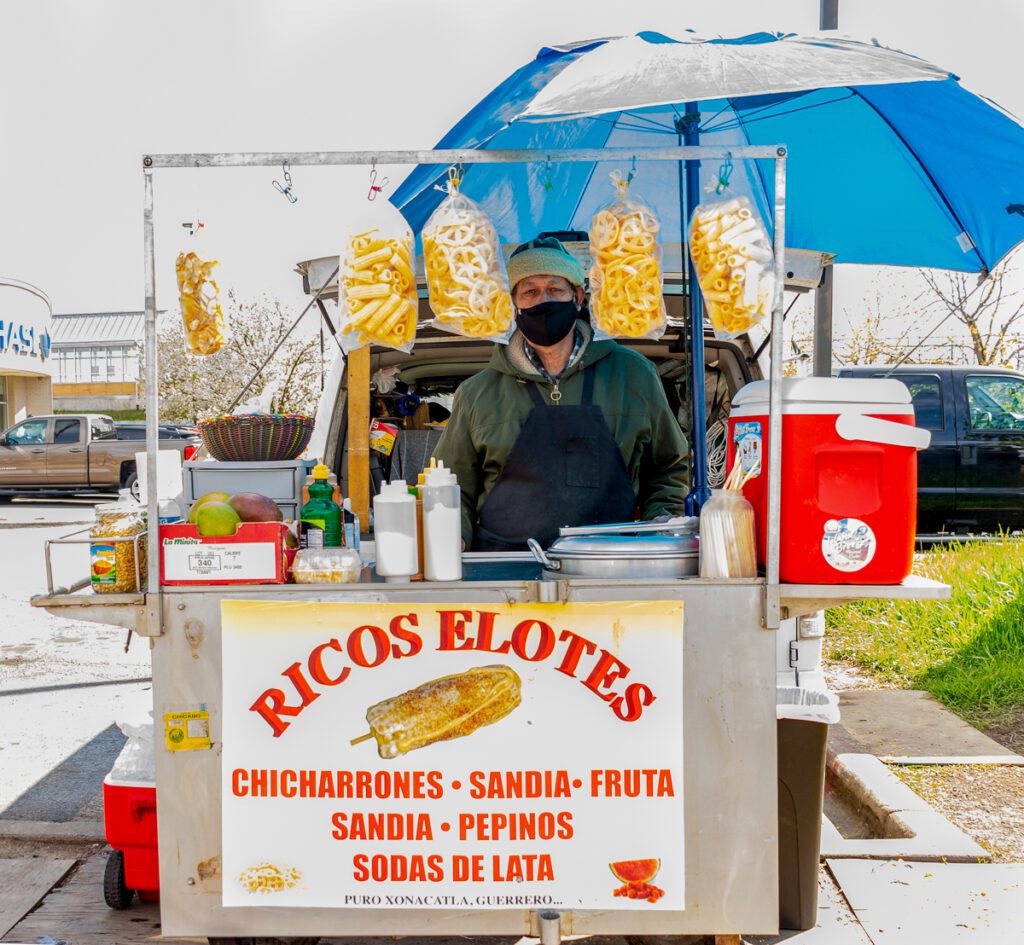
Moreno Herrera lleva año y medio vendiendo en los barrios de Hermosa y North Austin, en Chicago (Illinois). Es su trabajo a tiempo completo, y vende todo el día durante toda la semana. Esto le ha permitido invertir en un segundo carrito de comida, pero le está costando encontrar una persona de confianza que lo gestione por él. Foto de Natalie Garcia para Borderless Magazine
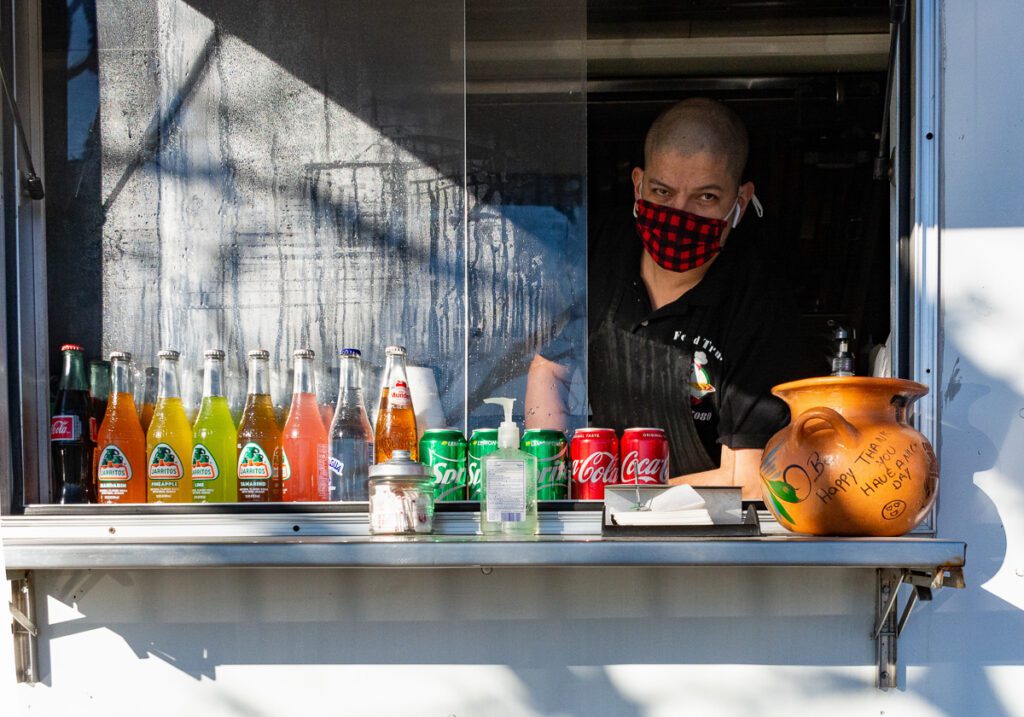
Aureliano López vende un menú rotativo de platos mexicanos populares como tacos, quesadillas y chilaquiles en el barrio de Belmont Cragin de Chicago (Illinois). Este era su primer año con un camión de comida como trabajo principal. Siguió vendiendo durante la pandemia, incluso durante el invierno, pero sus ventas cayeron drásticamente. Foto de Natalie Garcia para Borderless Magazine
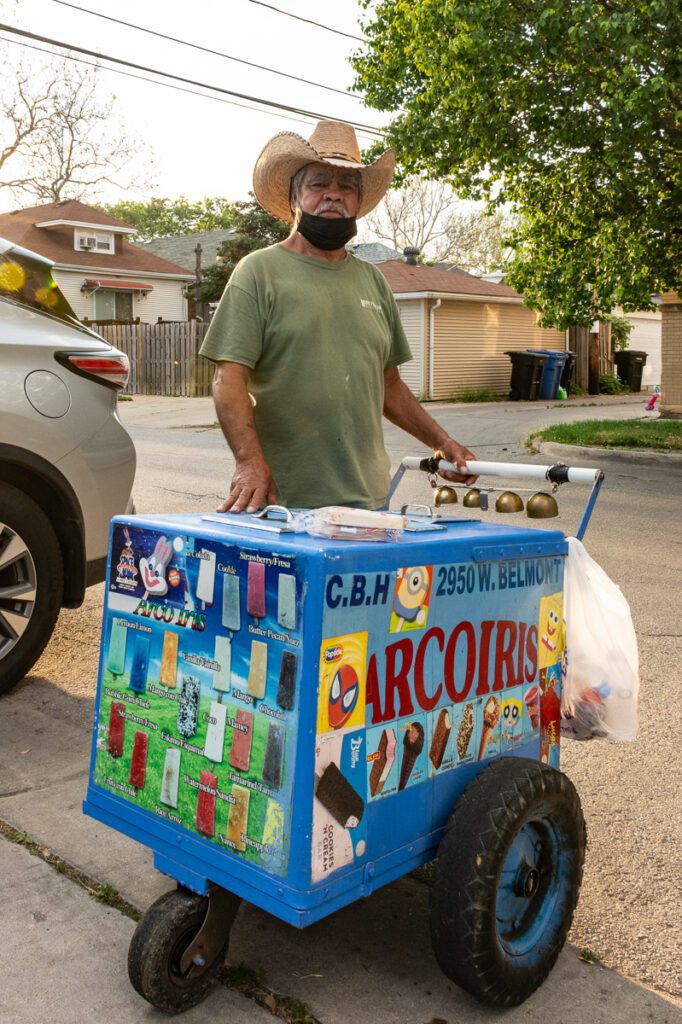
Fernando Nieto lleva 10 años trabajando y viviendo en el barrio de Hermosa, en Chicago (Illinois). Llegó a Chicago en 1996 y antes trabajaba a jornada completa en una fábrica, pero le suspendieron y acabó perdiendo el empleo. Como necesitaba otro rápidamente, se dedicó a la venta ambulante y ahora disfruta vendiendo paletas, ya que puede hacer su propio horario. Foto de Natalie Garcia para Borderless Magazine

